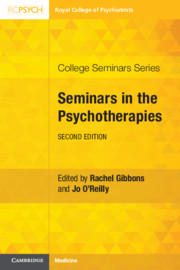Book contents
- Seminars in the Psychotherapies
- College Seminars Series
- Seminars in the Psychotherapies
- Copyright page
- Reviews
- Contents
- Contributors
- Foreword
- Preface
- Part I Therapy Theory and Practice
- Part II Applied Psychotherapeutic Thinking
- Section 1 Psychological and Psychodynamic Approaches to Psychiatry
- Chapter 13 Psychological Approaches to Affective Disorders
- Chapter 14 Psychological Approaches to Psychosis
- Chapter 15 Personality Disorder
- Chapter 16 Complex Post-traumatic Stress Disorder
- Chapter 17 Psychological Approaches to Medically Unexplained Symptoms
- Chapter 18 The Psychodynamics of Self-Harm
- Chapter 19 Psychodynamic Aspects of Suicide and Homicide
- Chapter 20 Forensic Psychotherapy
- Section 2 Work in Practice
- Section 3 Contemporary Developments
- Index
- References
Chapter 14 - Psychological Approaches to Psychosis
from Section 1 - Psychological and Psychodynamic Approaches to Psychiatry
Published online by Cambridge University Press: 27 May 2021
- Seminars in the Psychotherapies
- College Seminars Series
- Seminars in the Psychotherapies
- Copyright page
- Reviews
- Contents
- Contributors
- Foreword
- Preface
- Part I Therapy Theory and Practice
- Part II Applied Psychotherapeutic Thinking
- Section 1 Psychological and Psychodynamic Approaches to Psychiatry
- Chapter 13 Psychological Approaches to Affective Disorders
- Chapter 14 Psychological Approaches to Psychosis
- Chapter 15 Personality Disorder
- Chapter 16 Complex Post-traumatic Stress Disorder
- Chapter 17 Psychological Approaches to Medically Unexplained Symptoms
- Chapter 18 The Psychodynamics of Self-Harm
- Chapter 19 Psychodynamic Aspects of Suicide and Homicide
- Chapter 20 Forensic Psychotherapy
- Section 2 Work in Practice
- Section 3 Contemporary Developments
- Index
- References
Summary
This chapter will describe the psychological processes thought to underlie psychosis and how these approaches can assist our understanding and management of psychotic disorders. There is no single model for complex conditions and the main theoretical underpinnings and treatment approaches derived from psychodynamic, systemic and cognitive behavioural frames of reference will be outlined. Clinical examples will illustrate the application of these ideas in clinical care.
- Type
- Chapter
- Information
- Seminars in the Psychotherapies , pp. 175 - 189Publisher: Cambridge University PressPrint publication year: 2021

